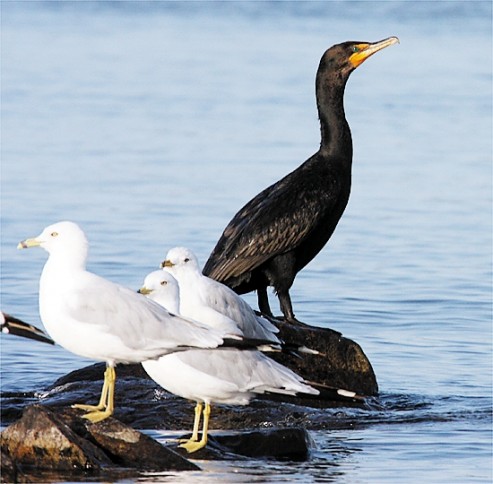Follow-up on Digest Survey Results
 Hello Digest readers,
Hello Digest readers,
Last week after we published the Digest survey summary and our proposed plan for improvements, we began receiving reader feedback. We are preparing to implement our plan soon, so if you have comments, please sent them to us (wdin@usgs.gov) by October 1, 2010.
To date, most of the feedback has been about the intended discontinuation of the ‘feel good' sections, It Ain’t All Bad and Huh, That’s Interesting. As mentioned in the results summary, survey participation was not as high as we had hoped for, leaving the survey open to potential bias. Hence, we would like to get more user input on this issue before making any decisions.
 We have created a poll on the Digest website, http://wdin.blogspot.com. If you feel strongly about not losing these news sections, please visit the site and cast your vote. The poll will close on September 16, 2010.
We have created a poll on the Digest website, http://wdin.blogspot.com. If you feel strongly about not losing these news sections, please visit the site and cast your vote. The poll will close on September 16, 2010.
If this poll is successful in gaining readership feedback, we may use this approach again for input on proposed Digest improvements.
Thank you,
The WDIN Team
Newcastle Disease implicated in bird deaths
A virulent strain of Newcastle Disease has been identified as the cause of a recent die-off of cormorants and gulls in some parts of Minnesota, and it remains an unconfirmed suspect in the deaths of cormorants on Lake Vermilion.
While the results of tests on the Lake Vermilion birds are not yet available, DNR officials are treating it as another outbreak of Newcastle.
According to Tom Rusch, with the Tower Area DNR, a total of 95 bird carcasses were recovered from Lake Vermilion’s Potato Island last Friday. Of those, a handful were gulls, but the vast majority were cormorants.

Independent tests find oil spill contamination in Louisiana oysters and crabs
Working with the Louisiana Environmental Action Network (LEAN) and the Lower Mississippi Riverkeeper, award-winning chemist Wilma Subra took samples of soil, vegetation, blue crabs, fiddler crabs and oysters in areas affected by pollution from the BP Deepwater Horizon oil spill.
The test results showed the presence of hydrocarbons corresponding to those from the spill in the soil and vegetation. They also showed high levels of hydrocarbons in sea life.
Hydrocarbon exposure has been linked to health problems including disorders of the nervous and immune systems, blood, liver, kidneys and lungs, as well as cancer.
>>> Deepwater doom: Extinction threat for world's smallest seahorse
>>> Wildlife rescue and recovery effort a success in Louisiana
Satellite Data Reveals Why Migrating Birds Have a Small Window to Spread Bird Flu
In 2005 an outbreak of the H5N1 'bird flu' virus in South East Asia led to widespread fear with predictions that the intercontinental migration of wild birds could lead to global pandemic.
Such fears were never realised, and now research published in the British Ecological Society's Journal of Applied Ecology reveals why the global spread of bird flu by direct migration of wildfowl is unlikely, while also providing a new framework for quantifying the risk of avian-borne diseases.
The highly pathogenic H5N1 bird flu virus is primarily a disease of poultry, often resulting in mass mortality for infected flocks.
Related News
>>>Officials look for signs of bird flu in North Dakota

Reported Wildlife Mortality Events to the USGS National Wildlife Health Center Updated
USGS and a network of partners across the country work on documenting wildlife mortality events in order to provide timely and accurate information on locations, species and causes of death. This information was updated on August 25, 2010 on the USGS National Wildlife Health Center web page, New and Ongoing Wildlife Mortality Events Nationwide. Quarterly Mortality Reports are also available from this page. These reports go back to 1995.
- A plague stalks sleeping bats [White Nose Syndrome, North Carolina]
- Bird tests positive for West Nile [Red Willow County, Nebraska, USA - Map It
 ]
] - Congolese chimpanzees face new 'wave of killing' for bushmeat
- Farmers Permitted To Cull Badgers [United Kingdom]
- Viewing Poisons at Our National Parks [USA]
Photo courtesy of iStockphoto
Deer
- Dramatic drop in deer population closing part of Big Cypress hunting season [Florida, USA]
- Will zeros in on deer-culling decision [Will County, Illinois, USA]
- Patty continues long, slow road to recovery at National Marine Life Center [diamondback terrapin turtle; Massachusetts, USA]
- Phoenix Zoo marks restoration of 10,000th frog to the wild [Arizona, USA]







